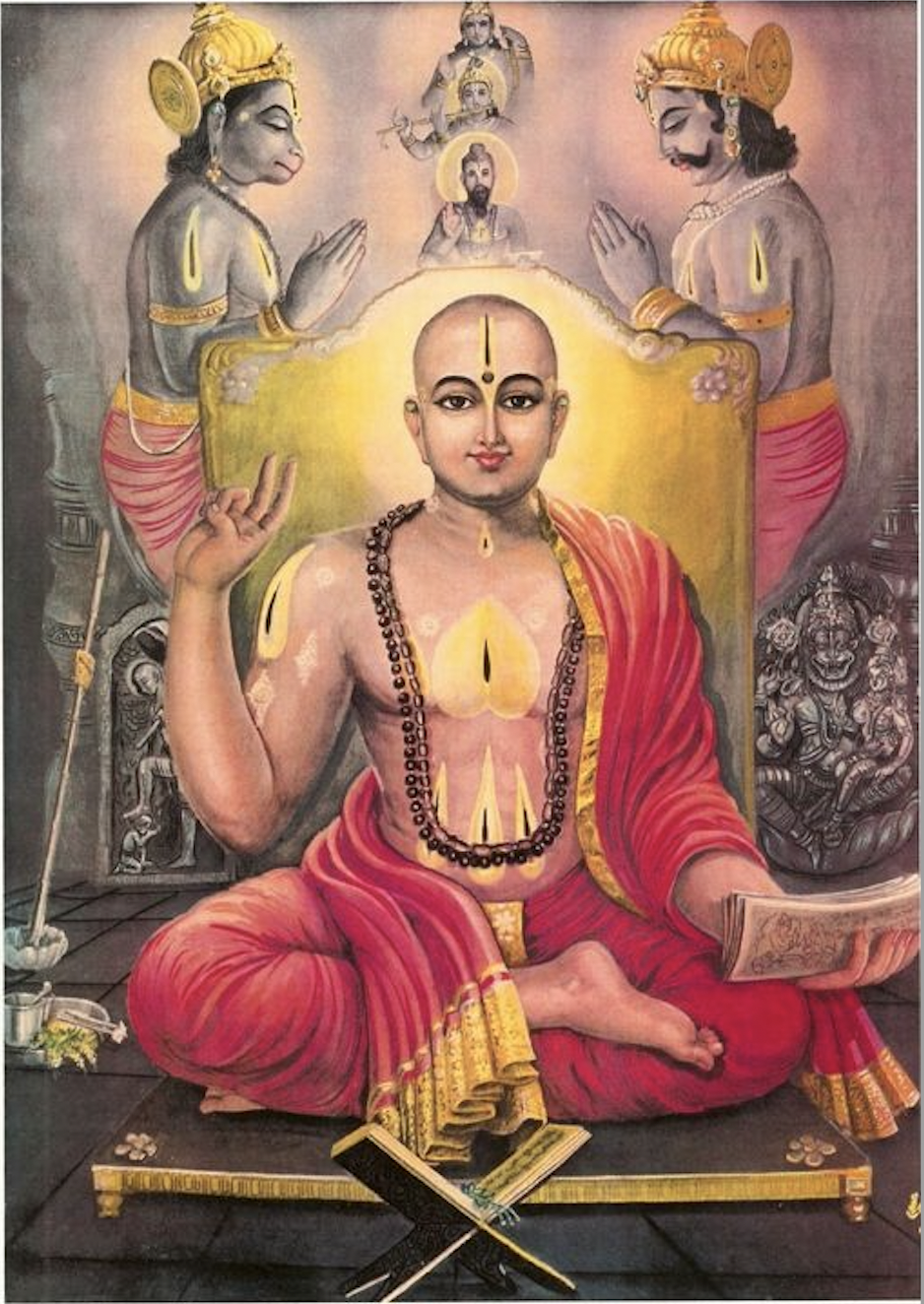MAṆI-MAÑJARĪ

By Śrīman Nārāyaṇa Paṇḍitācārya
(First Installment)
The first issue of our Śrīla Gurudeva’s Śrī Bhāgavata-Patrikā (June 1955) included the first portion of a Hindi translation of Māyāvādera Jīvanī vā Vaiṣṇava-vijaya, a rigorously researched book on the history of Māyāvāda, written by Ācārya-keśarī Śrī Śrīmad Bhakti Prajñāna Keśava Gosvāmī Mahārāja.
In keeping with that tradition, here we include the first polished English translation of an extraordinary gem of a book, Maṇi-mañjari, by Śrī Nārāyaṇa Paṇḍitācārya, son of Śrī Trivikrama Paṇḍitācārya (to whom Śrī Madhvācārya granted Śrī Narasiṁha Nakha Stuti).
Below, Śrī Śrīmad Bhakti Prajñāna Keśava Gosvāmī Mahārāja provides a compelling recommendation of Maṇi-mañjari that provides some of the history of Śrī Trivikrama Paṇḍitācārya, was granted:
“…Trivikramācārya was a great scholar and ācārya of the Advaita-vādī sampradāya. His son, Nārāyaṇācārya, wrote the books Madhva Vijaya and Maṇi-mañjari. Trivikramācārya later became a prominent ācārya in the line of Madhva. Therefore, he was particularly well-acquainted with both philosophies. It was by hearing from him, that Nārāyaṇācārya was able to convey a great deal about Śaṅkara and Madhva to the world. Therefore Śrī Nārāyaṇācārya’s books ought to be accepted by both Śaṅkara and Madhva lineages as very much authentic and important.” —Māyāvādera Jīvanī vā Vaiṣṇava-vijaya (page 96, Bengali edition).
Maṇi-mañjari is comprised of sweet, poetic summaries of Rāma-līlā and Kṛṣṇa-līlā, followed by a summary of events leading up Śrī Madhva's appearance. This text is clearly composed in honor of Śrī Madhva and his incarnations as Hanuman and Bhīma, whereby he decimates the influences of the Asuras and Rākṣasas, establishing goodness and devotion to Bhagavān.
MAṆI-MAÑJARĪ
prathamaḥ sargaḥ
First Chapter
śrīmad-hanumad-bhīma-madhvāntargata-rāma-kṛṣṇa-veda-vyāsātmaka lakṣmī-hayagrīvāya namaḥ || 0 ||
Obeisance to Lakṣmī-Hayagrīva and to Rāma, Kṛṣṇa, and Veda-vyāsa as present within Śrī Madhva, the incarnation of Śrī Hanumān, Bhīma, and their source, the Pavana (Wind God) of Vaikuṇṭha
vande govindām-ānanda-jñāna-deham patim śriyaḥ
śrīmad-ānanda-tīrthārya-vallabham paramakṣaram (1)
I bow unto Govinda, whose body is cognizance and bliss, whose consort is Śrī (Lakṣmī). He is the beloved of the venerable Śrīmad Ānanda-tīrtha and is supreme and indestructible.
sasarjja bhagavānādau trīn-guṇān prakṛteḥ paraḥ
mahat-tattvaṁ tato viṣṇuḥ sṛṣṭavān brahmaṇas-tanum (2)
Bhagavān Viṣṇu first created the three modes of material nature. From these three guṇas, He created the mahat-tattva (“the totality”), the body of Brahmā.
mahat-tattvād-ahaṅkāraṁ sasarjja śiva-vigraham
daivān dehān manaḥ khāni khaṁ ca sa trividhāttataḥ (3)
From the mahat-tattva, He created Śiva’s body, the ahaṅkāra-tattva (“the principle of ego”). Then, from three types of ego, He created the demigods who preside the various senses, He also created the mind, the senses themselves, and the sky. [Bhagavān created mind and the presiding demigods from sāttvika-ahaṅkāra (a sense of identity rooted in the mode of goodness), the ten senses from rājasa-ahaṅkāra, and the five gross elements from tāmasa-ahaṅkāra.]
ākāśād asṛjad vāyuṁ vāyos tejo vyajījanat
tejasaḥ salilaṁ tasmāt pṛthivīm asṛjat vibhuḥ (4)
From that pre-existing sky, He created wind, and from the wind, He created fire, from fire, He created water, and from water, the Earth.
tataḥ kūṭastham asṛjat vidhiṁ brahmāṇḍa-vigraham
tasminstu bhagavān bhūyo bhuvanāni caturdaśa (5)
From the above twenty four tattvas, Bhagavan created Chaturmukha Brahma, who is the patron deity for the whole universe (Brahmanda), consisting of seven upper and seven lower worlds.
tāttvikān atha devān ko vairājaḥ puruṣo ’sṛjat
tathaiva paramān haṁsān sanakādīṁś ca yoginaḥ (6)
Thereafter, the Virāṭa Puruṣa, Brahmā, created the elemental demigods and paramahaṁsa-yogīs, like Sanaka and others.
asurān doṣa-rūpān apy avidyāṁ pāñca-parvaṇīm
varṇāśrama-viśeṣāṁś ca dharma-kḷptiṁ ca so ’sṛjat (7)
Then he created the Asuras, who are the embodiments of doṣa (imperfections), as well as five-fold Māyā, varṇāśrama (caste and station in life), and the rules of dharma.
marīcy atryādayaḥ putrā abhūvan parameṣṭhinaḥ
marīceḥ kaśyapo jajñe vāmanasya pitā baṭoḥ (8)
In sequence, Prajāpati’s sons, like Marīci, Atri, and others took birth. From Marīci was born the greatminded Kaśyapa, father of Vāmanadeva.
prajāḥ sisṛkṣur-vividhā avahat kaśyapo ditim
aditiṁ ca danuṁ kadruṁ kīkasāṁ vinatām api (9)
Desiring to produce progeny, Kaśyapa Ṛṣi married Diti, Aditi, Danu, Kadru, Kīkasā, and Vinatā.
dityāṁ tato ’bhavan daityā adityāñca surāḥ punaḥ
danau tu dānavāḥ kadrvāṁ nāgā nānā viṣolvaṇāḥ (10)
From Diti were born the Daityas, from Aditi the Devatās, from Danu the Dānavas, and from Kadru were born various species of venomous serpents.
